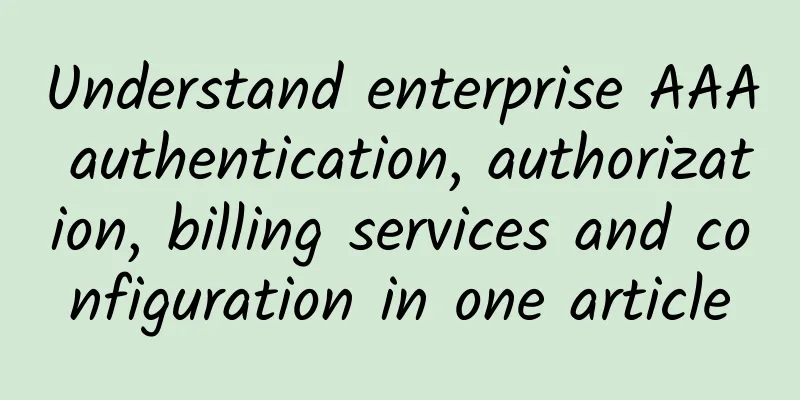Understand enterprise AAA authentication, authorization, billing services and configuration in one article

|
Hello everyone, I am Bernie, an IT pre-sales engineer. If a branch of an enterprise wants to access the headquarters network, the headquarters network is definitely not accessible to everyone, only those who have passed the authentication can access it, such as accessing the OA system, accounting system, ERP system, etc. This is when AAA authentication and authorization services come in handy. AAA is a security service that provides authentication, authorization, and accounting. It can be used to verify whether a user account is legitimate, whether it is authorized to access services, and record access to network resources. About CertificationAuthentication means verifying whether a user has access rights to a network. AAA authentication methods can be divided into three types: no authentication, local authentication, and remote authentication. Not certifiedIt is very simple, which means that the server completely trusts the user and does not perform any identity check on the accessing user. In fact, most networks will not use the non-authentication method because it is too simple and crude and unsafe. Local AuthenticationIt is to configure the user's local information as a parameter on the NAS storage. Local authentication processing speed is fast and the authentication cost is low. However, since the authentication information is stored locally, the amount of data stored is often relatively small. Remote AuthenticationThis method is more advanced. It configures the authentication information on a remote server and uses the authentication server to assist in authentication. Here we need to point out that if an authentication scheme adopts a composite authentication method, that is, multiple authentication methods coexist, for example, local authentication is configured first, and then remote authentication is configured. Then, when local authentication fails or there is no response, remote authentication will be used. About authorizationAuthorization refers to the definition of which services a user is authorized to access on the network. AAA supports the following authorization methods: no authorization, local authorization, and remote authorization. Not authorizedThat is, no authorization is performed on users. There is no restriction on user access, and users can access any service they want. Local authorizationAuthorization is performed based on the relevant authorization attributes configured on the NAS storage. Remote authorizationConfigure authorization information according to the remote server, configure authorization level, etc. Special note: If an authorization scheme uses multiple authorization methods, they will take effect in the configuration order, just like authentication. For example, if you configure remote authorization first and then local authorization, if there is a problem with the remote authorization method, you will request local authorization instead. About BillingBilling is to record a user's use of a service or access to a resource. Unlike authentication and authorization, there is no local billing method. There are only: no billing and remote billing. No chargeInternet access is completely free, and services are all free, such as a company's portal, government portal, etc. Remote BillingThe user's online time or service time is recorded through a remote server to calculate the cost of the service. For example, we can record the host name, online start time, service time, and upstream and downstream traffic during the service period. In this way, we can calculate the traffic cost or service cost. AAA domainAfter talking about authentication, authorization, and accounting, let's take a closer look at the concept of AAA domains. In fact, AAA manages users based on domains, that is, different domains can be associated with different authentication, authorization, and accounting schemes. In a computer network, each host belongs to its own domain. As shown in the figure below, PC1 belongs to areaA, and PC2 belongs to areaB. If you do not configure the domain where the device belongs, the default domain is used by default. SummarizeThe above is all about AAA authentication. For specific authentication configuration, you can first configure the domain authentication scheme, and then configure the domain authorization scheme and authorization method. The article comes from: IT Yizhichan . If you wish to reprint this article, please contact [IT Yizhichan] Toutiao account. |
<<: An article explains the principles of Docker network
>>: Second wave of 5G: 30 countries launch services by 2023
Recommend
Friendhosting adds a new data center in New Jersey, 30% off on all VDS on Tester's Day
Friendhosting sent the latest email, which inform...
After 5G technology, there may not be 6G base stations! Why do you say that?
When the 4G technology standards were announced, ...
The third generation of SD-WAN security
If local Internet access is not provided to branc...
How many hurdles does industrial digital transformation have to overcome? Wind River provides a cost-effective option that integrates the old and the new
[51CTO.com original article] "It's time ...
Symantec launches new information protection solution to automatically encrypt critical enterprise data
The Symantec Information Centric Security solutio...
Megalayer September promotion: Hong Kong dual E5 server from 399 yuan/month, Hong Kong 20G high-defense server from 499 yuan/month
Megalayer has launched its September event, offer...
CMIVPS: Hong Kong large bandwidth/US AS4837 line VPS host monthly payment 20% off/annual payment 30% off
CMIVPS is a Chinese hosting company founded in 20...
Baidu Takeaway Zhang Jian: Using software engineering thinking to solve operation and maintenance problems
[51CTO.com original article] On April 14, 2017, W...
5G Thinking and Development: 5G development is just in time
Mobile communication technology advances every te...
Operators should not set traps for unlimited data packages
Operators generously offer "unlimited" ...
Wang Xijie, CEO of Yunfan Accelerator: Deeply cultivating network transmission and adhering to the "exquisite" route
[51CTO.com original article] As 2017 enters the c...
How can IT operation and maintenance service providers keep WannaCry out? Hengyuan Zhicheng said that security needs to be prevented
[51CTO.com original article] It has been a week s...
Patents and standards proposals complement each other to start the battle for 5G commanding heights
Thanks to the contributions of national policies,...
How can edge computing win in the context of 5G "new infrastructure"?
Edge computing has become one of the hottest tech...
Ethernet Adapter Market to See Record Revenue Growth in 2022
According to a recent report released by DellOro ...









